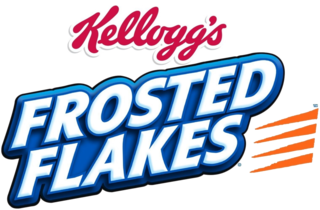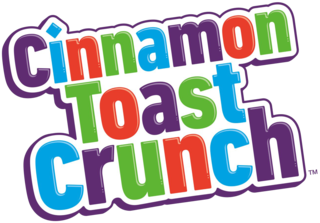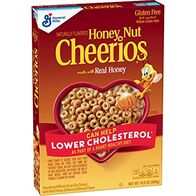
The almond is a species of small tree from the genus Prunus, cultivated worldwide for its seed, a culinary nut. Along with the peach, it is classified in the subgenus Amygdalus, distinguished from the other subgenera by corrugations on the shell (endocarp) surrounding the seed.

Porridge is a food made by heating or boiling ground, crushed or chopped starchy plants, typically grain, in milk or water. It is often cooked or served with added flavourings such as sugar, honey, fruit, or syrup to make a sweet cereal, or it can be mixed with spices, meat, or vegetables to make a savoury dish. It is usually served hot in a bowl, depending on its consistency. Oat porridge, or oatmeal, is one of the most common types of porridge. Gruel is a thinner version of porridge and congee is a savoury variation of porridge of Asian origin.

Lucky Charms is a brand of breakfast cereal produced by General Mills since 1964. The cereal consists of multi-colored marshmallows and pieces of shaped pulverized oat, each resembling one of several objects or symbols associated with good luck. The packaging and marketing features a leprechaun mascot, Lucky.

Breakfast cereal is a breakfast food made from processed cereal grains. It is traditionally eaten as part of breakfast, or a snack food, primarily in Western societies.

General Mills, Inc., is an American multinational manufacturer and marketer of branded processed consumer foods sold through retail stores. Founded on the banks of the Mississippi River at Saint Anthony Falls in Minneapolis, the company originally gained fame for being a large flour miller. Today, the company markets many well-known North American brands, including Gold Medal flour, Annie's Homegrown, Lärabar, Cascadian Farm, Betty Crocker, Yoplait, Nature Valley, Totino's, Pillsbury, Old El Paso, Häagen-Dazs, as well as breakfast cereals under the General Mills name, including Cheerios, Wheaties, Chex, Lucky Charms, Trix, Cocoa Puffs and Count Chocula and the other monster cereals.

Frosted Flakes or Frosties is a breakfast cereal, produced by WK Kellogg Co for the United States, Canada, and Caribbean markets and by Kellanova for the rest of the world, and consisting of sugar-coated corn flakes. It was introduced in the United States, in 1952, as "Sugar Frosted Flakes". The word "sugar" was dropped from the name in 1983.

Cinnamon Toast Crunch (CTC), known as Croque-Cannelle in French Canada and Curiously Cinnamon in the UK, and as a variant called Cini Minis in other European and Latin American countries, is a brand of breakfast cereal produced by General Mills and Nestlé. First produced in 1984, the cereal aims to provide the taste of cinnamon toast in a crunch cereal format. The cereal consists of small squares or rectangles of wheat and rice covered with cinnamon and sugar. The cereal is puffed and when immersed in milk, it makes a "snap" noise, similar to Rice Krispies. In most European countries and North America, the product is sold in boxes, but in Poland and Russia the cereal is sold in bags. The product was originally marketed outside Europe with the mascot of a jolly baker named Wendell. Wendell was replaced as a mascot by the "Crazy Squares", sentient Cinnamon Toast Crunch squares that often eat each other in commercials.

Cheerios is a brand of cereal manufactured by General Mills in the United States and Canada, consisting of pulverized oats in the shape of a solid torus. In some countries, including the United Kingdom, Cheerios is marketed by Cereal Partners under the Nestlé brand; in Australia and New Zealand, Cheerios is sold as an Uncle Tobys product. It was first manufactured in 1941 as CheeriOats.

Kix is an American brand of breakfast cereal introduced in 1937 by the General Mills company of Golden Valley, Minnesota. The product is an extruded, expanded puffed-grain cereal made with cornmeal.
Post Consumer Brands is an American consumer packaged goods food manufacturer headquartered in Lakeville, Minnesota.

Chex is an American brand of breakfast cereal currently manufactured by General Mills. It was originally known as Shredded Ralston, first produced in 1936 and owned by Ralston Purina of St. Louis, Missouri, then later renamed Chex in 1950. The Chex brand went with corporate spinoff Ralcorp in 1994 and was then sold to General Mills in 1997. Rival cereal company Kellogg's has the rights to the Chex brand in South Korea and Singapore.

Chex Mix is a type of snack mix that includes Chex breakfast cereal as a major component.
Mornflake is a British brand of oat and oat-based breakfast cereals launched in 1941 in Crewe, Cheshire.

A honey dipper is a kitchen utensil used to collect viscous liquid from a container, which is then dispensed at another location.

Fiber One is a brand of high-fiber breakfast cereal, packaged nutritional bars, and baked food products owned by General Mills. Originally released as a breakfast cereal in 1985, it directly competes with Kellogg’s All-Bran.

Nesquik is a brand of food products made by Swiss company Nestlé. In 1948, Nestlé launched a drink mix for chocolate-flavored milk called Nestlé Quik in the United States; this was released in Europe during the 1950s as Nesquik.
Bring Back the Bees, or #BringBacktheBees, is a hashtag activism campaign to raise awareness over the rapidly declining bee population. One of the leading causes of this drastic decrease is the use of harmful pesticides, such as neonicotinoids. These chemicals, also known as neonics, are among the most commonly used pesticides. They are used extensively in agriculture, as well as in home and garden centers. However, research has shown that exposure can kill bees directly, or make them more susceptible to other impacts like disease and climate change.
Fingos is a discontinued breakfast cereal snack from General Mills that lasted from 1993 to 1994. The cereal was advertised as a snack which confused consumers. The box was voiced in television commercials by comedian Steve Mackall.

Three Wishes Cereal, more commonly known as simply Three Wishes, is a breakfast cereal brand launched by co-founders Ian and Margaret Wishingrad in 2019.

















